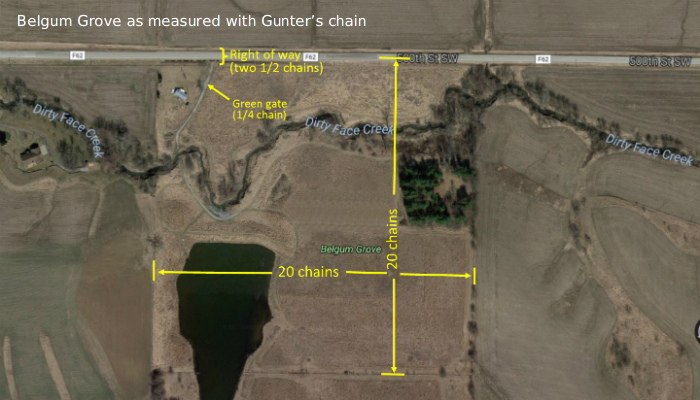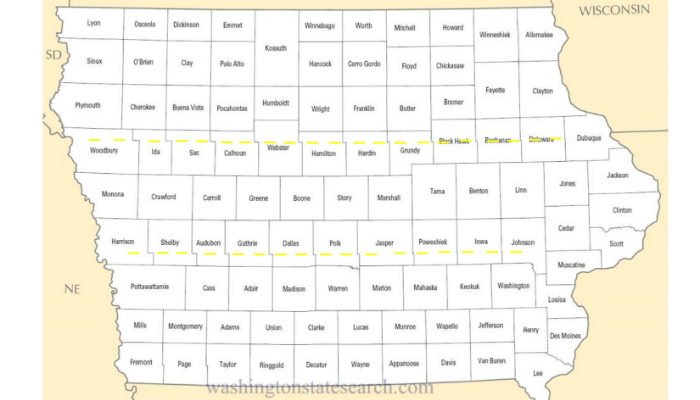Gunter’s Chain Still Measures Iowa

Ever since the dawn of agriculture, people have marked out parcels of land to claim the fruits of their hard-earned labor. Soon thereafter, successful governments also supported land surveying to provide the tax base needed in return for irrigation water, roads, defense, markets, subsidies, and other amenities that allowed agriculture to flourish. The Egyptians have been surveying and resurveying the Nile delta for at least 6000 years.
Ancient surveys usually involved some organic, repeatable measure of length – the king’s foot, stride, or armspan being a common choice – coming down to us today as the foot, yard, and fathom.
The measuring tool of choice for the original surveying of Midwestern and Western USA was Gunter’s chain, a lightweight wire link chain with “D” handles on the ends so it could be pulled taunt. Gunter had cleverly designed it to be useful in both the English and metric systems. For example, a full chain of 100 links was 66 English feet, but also 20 European meters. This made it useful in both the Indian territories being surveyed as well as portions of future Texas, California, Florida, and Louisiana, with already existing surveys by the Spanish and the French.
Land surveying came to Iowa after the Blackhawk War of 1832, when Blackhawk’s tribe was massacred by the Whites. Blackhawk himself was captured alive and paraded around eastern cities in chains, so politicians could demonstrate that they were dealing with the “Indian problem.” The other tribes in Iowa read the writing on the wall and either became pacified and/or sold out and moved westward, so these surveys proceeded without much conflict.
The Township and Range survey system in Iowa initially created townships containing 36 one-square-mile blocks, and these were defined by the fact that 80 chains created an English mile (80 x 66’=5280’). These blocks could later be divided into 16 forty-acre square blocks. A parcel made of ten square chain blocks was an English acre (66’ x 66’ x 10 = 43,560 square feet). At a still smaller scale, a farmer could snitch his wife’s cloth tape measure from her sewing basket and cut a long slender pole to be a quarter chain long, 16.5 feet, conveniently also called a rod, and use it to measure around the farm.
And these measures are still in use today, even though Mr. Gunter and his chain have been forgotten. When you drive on country roads, the right-of-way (many times bordered by fences) is usually one chain wide, a half-chain on either side of the centerline. When you buy a cattle panel or a farm gate, it is 16 feet long, a nominal quarter chain. Agricultural land is still commonly bought and sold in 40-acre blocks, and this is why, for example, that Bur Oak Land Trust’s Belgum Grove is a 40-acre square parcel (see photo with Gunter’s chain measurements included).
And no matter how perfect your measuring tool is, even using GPS accurate to a gnat’s eyebrow, a perfectly square survey grid does not actually fit onto a spherical earth. The original surveyors knew this and kept track of the growing error as their surveyed square grid extended north or south. And at some point they decided to terminate that grid against an east-west line and start over. These “correction lines” show up readily as sets of jogs in the county boundaries of Iowa and are also present as offsets in north-south roads and fence lines, readily seen on topo maps and aerial images. When we first moved to Iowa, I thought that the town of Correctionville must have a prison, but soon learned that it straddled a survey correction line, with its offsets in roads and property lines.

The two most conspicuous original survey correction lines across Iowa. You can see the cumulative error growing as the surveys worked their way westward. Also note the size of Kossuth County.
Geologically, biologically, and culturally, the past is always with us, often exerting more influence behind the scenes than we recognize, even in places you might never suspect. Did you know that in major league baseball the distance from the top of the pitcher’s mound to the center of home plate is exactly one chain? Did you know that Iowa was supposed to be divided into one hundred more or less equal counties, but today’s Kossuth County was such an enormous swamp that the politicians of that era assumed it would barely be inhabited anyway, and it is merged from two potential counties?


